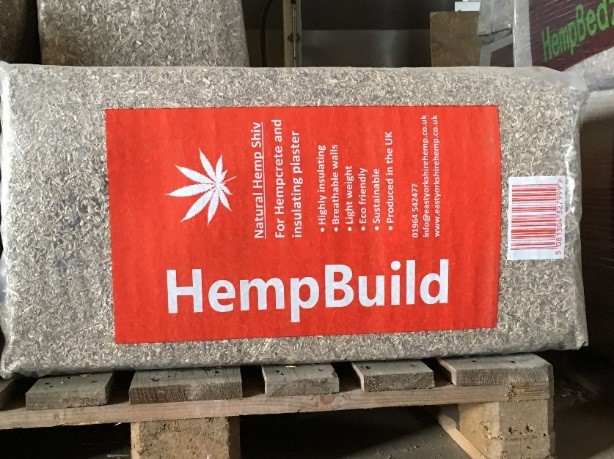Building Products
Sustainable Building Products
A whole range of sustainable building products are currently being made from all parts of the hemp plant for use in restoration and new build projects. Hemp construction uses renewable crop-based materials that absorb carbon dioxide (CO2) as they grow, providing an opportunity to capture and store CO2 in the fabric of buildings. Hemp fibre is made into ‘user-friendly’ recyclable loft insulation which does not contain harmful ingredients. Compressed hemp shiv is used to make fibreboard but by far the most exciting development is Hempcrete, a material that can be used for construction.
Hempcrete
Hemp construction uses renewable crop-based materials that absorb carbon dioxide (CO2) as they grow, providing an opportunity to capture and store CO2 in the fabric of buildings for their entire lifespan. Sustainable building products are being made from all parts of the hemp plant and are ideal for use in both renovation and new build projects. Hemp fibre can be made into “user-friendly” recyclable loft insulation which does not contain any harmful ingredients and compressed hemp shiv is used to make fibreboard, but by far the most exciting development is hempcrete, an insulating material that can be used for construction.
Hempcrete is simply hemp shiv combined with lime and water as binding agents to make a soft mix which is then cast around a light timber frame (to give stability) using removable shuttering, it is then lightly tamped down to make a rigid but lightweight wall. Alternatively, the walls can be “built” by spraying 300 mm of hempcrete onto wood wool boards attached to the inside of the timber frame, or by using pre-cast hempcrete blocks, or factory assembled hempcrete-filled building panels. A 300mm hemcrete® wall absorbs 40kg CO2 during its construction while a typical brick wall emits 100kg, giving a net benefit of 140kg. Hempcrete is carbon negative.
Hempcrete replaces all the materials currently used to construct walls: bricks, mortar blocks, cement, cavity ties and closers, insulation and plasterboard. It provides both structure and insulation within one solid wall. A hempcrete wall has excellent thermal properties; as well as having very low u-values (a 300 mm wall = 0.2 W/m2K), it also has high thermal inertia – similar to thermal mass – which means that the temperature in a hempcrete building changes very slowly because the walls absorb heat and then release that same heat back into the building as the air temperature falls; greatly reducing heating requirements.
The process of making hempcrete results in ‘petrification’ (turning to stone), however, hempcrete retains some of the qualities of the plant matter: it is lightweight with an open texture so requires shallower foundations with resulting cost savings. The lime binder provides protection to the timber frame in terms of resistance to rot and so removes the need for any further chemical treatment. Hempcrete is also resistant to fire and vermin.
Hempcrete’s flexibility and breathability make it ideal to use with other natural materials. HempBuild can also be used during the renovation of houses built with bricks and lime mortar, these houses rarely have a wall cavity. HempBuild plaster applied to internal walls during refurbishment gives the benefits of a hempcrete wall providing both insulation and breathability to these old buildings. It creates an attractive textured finish ready to decorate with coloured limewash, clay-based paint or any other breathable paint.

IndiNature are about to launch their new products
IndiTherm® loft insulation batts and IndiBoard® semi-rigid insulation boards both made from hemp fibres and can be used in buildings for insulation between rafters, joists and studs, providing excellent thermal insulation performance and also provide good acoustic insulation. Both products can be used individually in any building type – but when combined they create a highly efficient insulation system – IndiBreathe®
Hemp fibre insulation is highly breathable, safe (contains no irritating fibres) and can be recycled.
www.indinature.co.uk
Breathability
Hemp-lime composite materials absorb moisture vapour and allow it to pass through the fabric of the building; This effect is known as ‘breathing walls’. Structures built from non-breathable materials can trap moisture, which is very likely to cause mould growth, particularly if there is insufficient ventilation and high levels of condensation. Breathability also helps to protect the fabric of the building, particularly against decay in the timbers.
Hemp and lime masonry construction is unique because it provides a method of building which is structurally sound, can provide thermal and acoustic insulation, thermal mass and storage but can also be used as the external skin of a building. It is extremely simple to construct, using just one method to meet many very different requirements for walls, floors, and even roofs.
HemShiv for hemp-lime building can be delivered to your project – contact us today on 01964 542477 or by email to info@eastyorkshirehemp.co.uk to discuss your requirements.
Lime binder for mixing with hemp shiv to make your hempcrete can also be supplied. For larger projects please contact one of the hempcrete installers listed on our ‘Building a Hemp House’ case study page.
Better for the environment
Hemp construction uses renewable crop-based materials that have absorbed carbon dioxide (CO2), providing an opportunity to capture and store CO2 in the fabric of buildings. It is claimed that hemp and lime can lock up approximately 110 kg of CO2 per m3 of wall.



